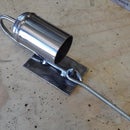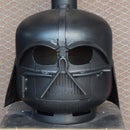Introduction: Make a Spit for Roasting Whole Pigs
Hello and welcome to my instructable.
Some years ago I spent a couple of years working and living in the Philippines. I thoroughly enjoyed my time there; the tropical climate, the unique culture, the wonderfully warm hospitality, the food... Oh, the food!
I was living in friendly, relaxed Cebu City. One of the most famous culinary specialities of Cebu is Lechon Baboy, a whole pig roasted over charcoal. This dish is frequently served at big celebrations and fiestas, and is always quickly devoured, leaving only a skeleton to be shared out for making soup.
Now I'm back in Australia with my Filipina wife, and I still like my Filipino food, so I have been inspired to build a spit for roasting pigs. Basically a container for burning charcoal with a rotating shaft to hold the pig. I also wanted to make something that didn't look too out of place in my yard when it was not cooking pigs. In this Instructable I will try to share how I've done it.
As with most of my I'bles my goal is not to dictate the minutiae, but to inspire others to do their own build. If you would like to know any details I have not included please feel free ask in the comments below.
Step 1: Design
I have based this design on a fire pit I featured in an earlier Instructable. Click here to see it.
All I did was make the fire pit longer, gave it vertical sides, and added legs and uprights to support the rotisserie.
The removable uprights allow it to be used as a nice big fire pit, added grills make a regular barbecue, and the added top turns the unit into a handy outdoor table with storage for the accessories.
I started making a rotisserie out of bicycle parts and a mix master motor, but it was an abject failure so I bought a proper one on line for about $100.
The shaft or skewer is made from hexagonal stainless steel shafts from submersible bore pumps. I just happened to have these. I also used pump shafts for making the prongs for holding the pig. I'm lucky to have access to have access to pump parts and old broken pumps, otherwise I would have to buy the steel.
Step 2: What You Might Need
I prefer to use materials that have been discarded by others. It's good for the environment and cheap. In this case I did buy the most of the steel, but I found the stainless steel and the timber. This list is what I used. Please just treat it as a guide to be adjusted depending on your taste or what is available.
Materials
- Steel Plate. 2.1mm Chequerplate. One sheet 1200mm x 2400mm.
- 50mm equal angle. About 6m.
- Stainless steel shaft for the skewer. 1.5m
- 50 x 25 RHS. About 2m.
- Lighter SS shaft for the prongs.
- SS bolts and nuts for grub screws.
- Scrap stainless steel for making the sleeves for the prongs.
- Timber for the table top. I used pallet timber.
- Paint. Pot Belly Black. It's good for hot things.
Tools and Equipment
- Welder (I used a MIG with both SS and Mild Steel Wire)
- Plasma cutter
- Angle grinders (for cutting, grinding and wire brushing)
- Hammer
- measuring tape
- Square
- drill
- clamps
- vice
- all the normal workshop stuff
- Ellipse drawing thingamajig. 4x2 with some cord attached to it - I'll explain later.
- PPE.
Step 3: Marking Out, Cutting, Assembly
I got so excited doing the build that I forgot to take photos for part of it. Use your imagination and I'm sure you'll get a superior result than following my pictures anyway. Or look at my firepit Instructable that I mentioned earlier here.
See the pictures for a dimensioned sketch of the the sheet metal.
Here's a cool tip: use a metallic Sharpie for marking steel to make it easier to see while plasma cutting.
To make the attractive elliptical ends I adapted this Instructable by Intoon. I just scaled it up for the workshop.
Start by assembling the fire box part. As in my earlier fire pit instructable I tried to use a cut and fold technique. In hindsight it would probably be easier to cut out each face and then weld them together. The bending was really difficult with such long folds.
Once you have the fire box assembled add some legs. I just used 50mm equal angle iron jammed into the corners and welded into position. Choose the length based on how high you want it to be - mine are 500mm long.
I added angle-iron cross members between the legs. The ones at the ends support the vertical supports of the rotisserie. The ones on the side add some strength and can be used to support a shelf.
Step 4: Build the Rotisserie and Accessories.
The rotisserie is made up of a pair of vertical supports, a bracket to support one end of the skewer, a motor to turn the skewer, the skewer, and prongs to hold the meat.
The motor and the bracket can be moved up and down the vertical supports to adjust the heat. They are locked into place by grub screws.
The two vertical supports are made from about a metre each of 50x25 RHS. I cut slots inside each end of the fire box to fit them. They are dropped through the slots and sit on the cross member between the legs. I welded a lug onto the cross members to hold the bottoms of the supports in place. Remember to make sure the supports are positioned off-centre so the skewer is at the centre.
The bracket and the motor are both attached to a RHS socket sized to slide over the vertical supports. Each has a grub screw to lock them at the desired position. The grub screw is a nut welded over a hole in the RHS through which a bolt can be tightened against the support. Weld a handle to the head of the bolt to make it easy to use without a spanner.
The motor was purchased through Ebay. I had to make some modifications to make it fit my supports; I should have got the motor first and sized the supports to suit. Another lesson learnt the hard way.
My skewer shaft came in three pieces. Each had a threaded hole in each end, making them easy to join and disassemble. Sharpen one end so it can be easily pushed through the pig. The other end has to be adapted to suit the motor. See the pictures to see how I cut a slot to take the drive pin. I also cut a slot around the shaft at each end to sit on the brackets so it can spin without walking off.
The prongs are made made from some stainless steel bar welded to tube that fits over the skewer. Grub screws similar to the ones described above lock them into position on the skewer. I just guessed to design of the prongs with some help from some Google image searching. After cooking my first pig I realised that my prongs were not as long as they could have been. I woul;d make them at least 300mm long next time. I had to resort to the old fencing wire and Cobb & Co hitch to hold it really securely.
To hold the spine straight I made a couple of stainless steel plates with slots to pass stainless steel cable ties through. The plate goes on the outside of the back of the pig and the cable ties penetrate the skin and go around the skewer and back out again. They are fastened tightly over the plate. See the pictures. In hindsight I think it would be preferable to use a U-bolt, but I did not have any at the time.
When I first put a whole pig on the skewer I realised that it was not evenly balanced and I was worried that the motor would have trouble turning it. I made a last-minute adjustable counter-weight. It is really rough but it did the trick. Its a simple rod with a weight that can slide up and down. I drilled a series of holes in the rod so the weight can be secured at intervals with a pin. See the pictures for more details.
Step 5: Make a Table Top
Having a spit roaster is a great thing on those rare occasions when you need to cook a pig, but for the rest of the time it just takes up space. That's why I decided to give mine a top to convert it into a table when not in use. An additional benefit is that all the spit accessories can be stored out of sight under the top until needed.
The top is simply pallet wood held together by an angle iron frame made to fit snugly over the top of the fire box.
My plan is to make drop down legs for the top so it can become a full height table while the spit is being used.
Step 6: Finishing
I painted all the mild steel parts with "Pot Belly Black". Its paint for hot things like stoves.
The timber can be stained and varnished, or just oiled.
The stainless steel parts should be cleaned thoroughly before being used for cooking. Don't paint them.
Step 7: Lessons Learnt the Hard Way
Here are a couple of things I learnt along the way.
- Measure twice, cut once. You'd think I would know that already at my age.
- Be sure the uprights are parallel or the skewer won't sit on the bearings at all heights.
- Measure twice, cut once.
- The prongs need to be at least 300mm long.
- Manually folding the steel is too difficult on large pieces. Better to cut and weld.
- Buy the motor before making the uprights. It's easier to size them to fit rather than having to adjust the motor mounts.
Step 8: Conclusion
My aim was to build a spit roasting barbecue that converts to a piece of functional and attractive outdoor furniture and my deadline was my wife's birthday party yesterday. I'm pleased to say that I managed to achieve both. The party was a big success attended by a large group of expatriate Filipinos, and they all seemed to enjoy the pork along with lots of other delicious treats.
I hope that you have enjoyed my Instructable, and that it might have inspired you to try something similar. If you do please post a picture in the comments. And if you have any questions or comments please post them and I'll do my best to provide answers.
By the Way: I'm planning to document the cooking process so follow me if you are interested.
I'm entering this in the Metal Contest so please vote if you think I deserve it.
ALSO, I'm planning to offer these units (and others) for sale and will have an online store up and running shortly. Meanwhile you might be interested in visiting my Etsy Shop by clicking here.

Second Prize in the
Summer Food and Drink Contest

Participated in the
Outside Contest

Participated in the
Metal Contest











